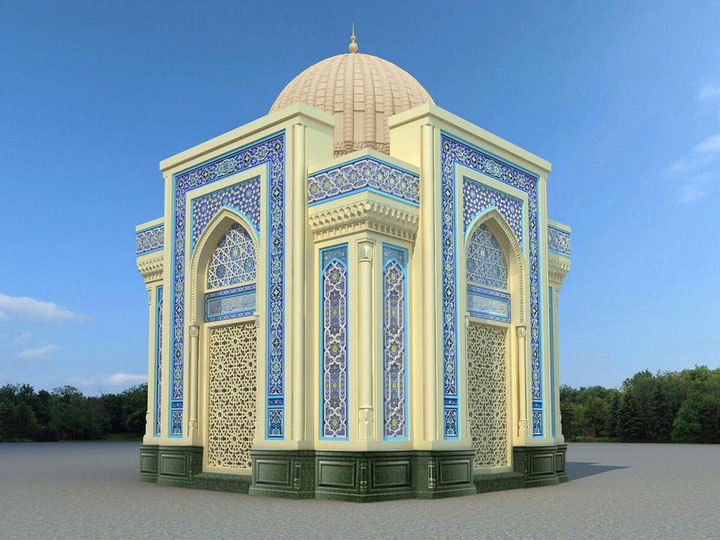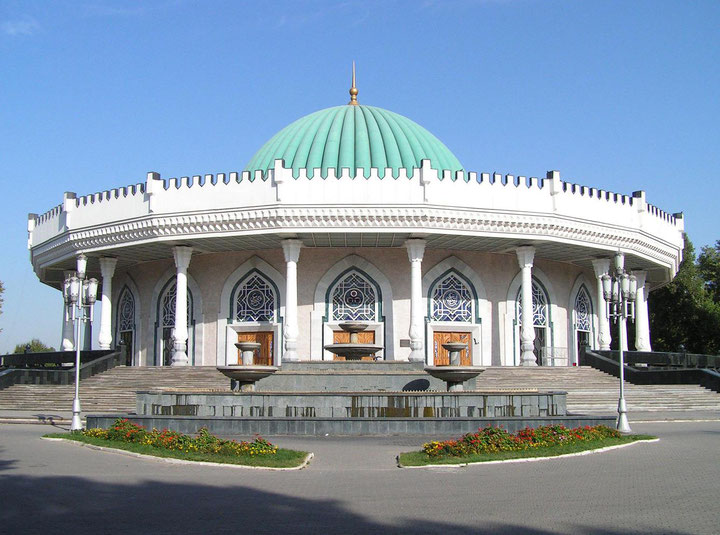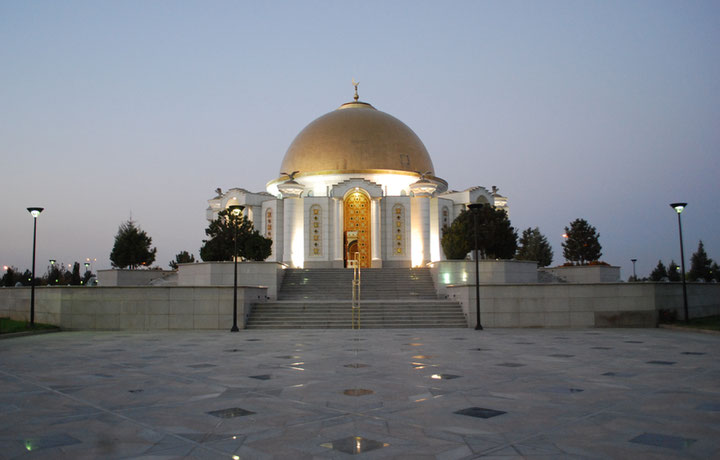Issue 3/2017 - Das Imperium schlägt zurück?
The Return of the Repressed Empire
The Case of Uzbekistan
In April 2017, two telltale events occurred in official art in Uzbekistan, the former Soviet republic, now independent, situated at the heart of Central Asia. First, the designs of a mausoleum and, then, a memorial for Islam Karimov, the country’s first president, who died in August of last year after ruling Uzbekistan for over a quarter of century, were made public. Aside from official declarations about memorializing the country’s first president, the events had unexpected implications, some of which we shall try and outline in this article.
Karimov’s career was typical of post-Soviet leaders generally and modern Central Asia particularly. Karimov was a high-ranking official, later named First Secretary of the Uzbekistan Communist Party, who succeeded in hanging onto power as perestroika came to an end via performing a rapid, dismaying about-face, making the transition to advocate of the market economy. In the process, he built a new nation-state and, although he had been a Russian-speaking proponent of average Soviet values, he championed Central Asia’s “great past” and commissioned a new reading of Uzbekistan’s history in which the country would figure as more ancient and wealthier than it had been in the history of the former imperial metropolis.
Karimov based all his policies on eradicating everything Soviet. Soviet building estates were rebuilt, their new facades decked out in gold and tinted windows. Soviet monuments were demolished or, at best, deported to distant hideaways. A monument to Marx was replaced with an equestrian statue of the medieval ruler Tamerlane, while a statue of Lenin made way for a monument to independence in the shape of globe on which the only country, Uzbekistan, was shaped like a huge, unknown continent. Marxist books were removed from libraries, and the word “Soviet” was banned from everyday use. At some point, Uzbek publishing houses even excised the word from references to scholarly journals such as Soviet Archeology. The communist toponymy ceded to a patriotic nomenclature in which the Great Fatherland War was renamed World War Two.
The eradication of all things Soviet kept up throughout Karimov’s entire regime, and in this sense the two memorials to him, the mausoleum and the monument, should have wrapped up his long, fierce battle with the past. Something strange happened, however. The forms and idiom of these final buildings-cum-statements harked back to the painfully familiar recent past.
However, the initial impression was that the design of Karimov’s mausoleum resembled a typical exemplar of traditional Islamic architecture, which was emphasized by its placement in the historic core of Samarkand, opposite the world-famous Shah-i-Zinda memorial ensemble, built primarily during the fourteenth and fifteenth centuries. Espying the building’s hidden implications would require us to examine it in the context of twentieth-century mausoleums, which were typical of Islamic, Stalinist and, later, post-colonial countries.
In the early 2000s, it was announced that a mausoleum for independent Azerbaijan’s first president, Geydar Aliyev, would be built in Baku, but the project came to a standstill, and the ruling dynasty, whose power has been growing, has for the time being limited itself to a deluxe family burial mound in a memorial avenue. In Pyongyang, Kim Il-sung’s former palace was converted into the Kim dynasty’s mausoleum. The size of Heathrow Airport, it is asymmetrical, has room to grow, and is happily located in parklands. In Turkmenistan and Uzbekistan, the regimes of the first presidents were not turned into dynasties, and so the crypts of the founding fathers took the guises of domes, with the main tombs in the middle. From the outside, the mausoleum of Turkmenistan President Saparmurat Niyazov (aka the Türkmenbaşy or “Head of the Turkmen”) resembles the mausoleum of Tunisia’s first president Habib Bourguiba, while outwardly it recalls the heavily ornamented Dôme des Invalides in Paris, which contains Napoleon Bonaparte’s sarcophagus. The Uzbek design is more traditional. Its architects were inspired by the mausoleums of the Timurids, located in Shah-i-Zinda.
Not everyone gets a mausoleum built for them nowadays. Fidel Castro was buried in Santiago under a large, gray cobblestone; Léopold Senghor, in an ordinary graveyard in Dakar; and Nelson Mandela, in the cemetery of his native village. Mausoleums were erected for Yasser Arafat; Hafez Assad, who ruled Syria from 1970 to 2000; Kwame Nkrumah, who declared himself Ghana’s president for life in the early 1960s; and Omar Bongo, who was Gabon’s president for forty-two years. Bongo was inspired by his friend Mohammed V, King of Morocco. Two traditions intertwined in most of these cases: the medieval Muslim tradition and the Stalinist totalitarian tradition. For, as we remember, by planning the construction of Lenin’s mausoleum, Stalin set the pattern for the memorial ensembles of the twentieth century’s secular dictators, a pattern later reproduced in such countries as Bulgaria, North Korea, and Vietnam. Therefore, to understand the extent to which Karimov’s mausoleum harks back to the Muslim tradition or Soviet tradition, we would have to have examine it in terms of a broader social and cultural context.
While all things Soviet were the first Uzbek president’s obsessive phobia, “Islamist radicals,” real and fictitious, were portrayed by him as the only serious political threat to the country. Hence, confronting them served to justify a policy of continual crackdowns and the president’s monopoly on power. In official Uzbek art, whose leading lights had tried to draw inspiration from Koranic subjects in the early 1990s, the topic of Islam would come to be interpreted in terms of Sufism, hedonism, and pantheism. In these experiments, Islam was an increasingly abstract source, more stylistic and decorative than truly religious.
As for content, the Orientalist version of socialist realism dominated the republic’s fine arts. It was strongly encouraged and promoted by the Uzbekistan Academy of Fine Arts, specially established by the newly independent state. Grand portraits of “positive” heroes returned to painting: the ubiquitous Tamerlane replaced paintings of Lenin in his study and Klem Voroshilov astride a horse. The substitution made it possible not only to destroy monuments erected under the Soviet regime, but where possible modify them slightly. Perhaps the best example of this was the multi-figured bas-relief in the Lenin Square subway station in Tashkent, which depicted the happy transfiguration of Uzbek life with the advent of Soviet power. In the late 1970s, sculptor Yakov Shapiro had depicted workers, peasants, and the labor intelligentsia celebrating freedom against the backdrop of a huge figure of Lenin. In the 1990s, the supreme leader was replaced by Uzbek musicians playing traditional instruments. The inscription “The sun of freedom shone through the years” was erased, since it was a citation from the Stalinist-era Soviet national anthem, although the phrase’s sense remained relevant. The bas-relief had now come to depict the happy transfiguration of Uzbek life after the Soviet regime’s departure.
In the architecture of Uzbekistan, the Soviet version of the International Style and brutalism, strikingly embodied by the Panorama Cinema (1964; Vladimir Berezin, Sergo Sutyagin, Yuri Khaldeyev, and Dmitry Shuvayev, architects; originally built as the Tashkent Arts Palace) and the House of Cinema (1978; Rafael Hairutdinov), have been replaced by references to historical architecture, with its symmetrical stasis, ornamentalism, blue domes, and “oriental” columns. However, latent antitheses were hidden even in such projects. Thus, the architects who designed the Museum of the Timurids (1995), the Oliy Majlis (1997; the Supreme Assembly, Uzbekistan’s parliament), and similar buildings were directed by the regime to reproduce certain traits of Timurid architecture, but in fact the buildings were reminiscent of the Orientalist pavilions in the Stalin-era VDNKh (Exhibition of Economic Achievements), in Moscow, and the holiday hostels built in Sochi during the same period. Similarly, the new architecture of Ashgabat, capital of independent Turkmenistan, evoked in the memories of architecture historians Stalin’s grandiose daydreams for redeveloping Moscow’s principal thoroughfares.
Yet the Uzbek version of socialist realism (like its Turkmen, Kazakh, Tajik, and Kyrgyz counterparts) had two notable features. The first had to do with the period depicted. Socialist realism’s cornerstone was an appeal to the future, to a life portrayed according to the templates supplied by communist slogans and programs. A Kyrgyz girl walking to school through the steppe; waterpipes being laid in medieval neighborhoods; morning at a hydroelectric plant; a train exploding the desert’s silence: these were the guises the future took in Central Asian art from the thirties to the seventies. The lives of “progressive” people from the past were an organic component of the socialist realist picture of the world, in which history figured as a sequence of natural steps towards the birth of the great communist tomorrow.
After the Soviet Union’s collapse, the future disappeared from Uzbekistan’s art. The future was not imagined, assumed or projected, neither as part of the official art encouraged by the Academy of Arts nor amid the shadows of underground art. Even in cases in which futurology was seemingly unavoidable, artists ignored it. Perhaps the most eloquent example of the process were the frescoes at the Museum of the History of Uzbekistan (1995), in which Bahodyr Jalalov tasked himself with providing an integral illustration of national history. Unlike other, similar multi-figure portrayals, in which the nation moves along the axis of past-present-future, the movement in Jalalov’s frescoes was cyclical, beginning and ending with a portrait of President Karimov. In the noughties and 2010s, the Academy of Arts picked up this line, highlighting the figures of itinerant dervishes, wandering a timeless universe in circles. As projected by Soviet art, the perfect future surrendered either to a perfect past or perfect timelessness, to the silence and grace of the Garden of Eden. The generic lineaments of this “emergent happiness” (to cite a current phrase from Turkmenistan's political lexicon) were latent in socialist realist art, no matter how dissimilar the chronotopes of Soviet art and post-Soviet Central Asian art might have seemed.
The truncation and memorialization of socialist realism reached their logical conclusion in the designs submitted in 2017 to the competition for the memorial to Karimov. Sculptors from different generations entered the competition. Some of them were educated as artists under the Soviet regime, which was committed not only to communist slogans but also to the principles of classical fine arts education, little changed since the days of the Bologne Academy. Other artists, on the contrary, were recent graduates of the Uzbekistan Academy of Arts, whose curriculum, in keeping with requirements dictated by the new ideology and Karimov himself, had been refocused on local art history. Figuratively speaking, classic Soviet sculpture, as incarnated by Vera Mukhina and Yevgeny Vuchetich, gave way to the old pre-Islamic tradition, as exemplified by the so-called Kushan Prince and other clay statues produced under the ancient kingdoms. However, whatever the age of the participating sculptors, their designs for the memorial to Karimov were variations on canonical Soviet monuments to Lenin: Lenin as Supreme Leader, Lenin the Orator, Lenin Showing the Way, Lenin with a Girl, etc.
In the noughties, Kazakh artist Erbossyn Meldibekov gained renown for a series of busts of Lenin that mutated depending on the circumstances and the country for which they were destined. The series thus included Lenin as a Kazakh, Lenin as Mao, Lenin as Ho Chi Minh, a Giacometti-style Lenin, and so forth. There is no sculptor of Meldibekov’s stature in Uzbekistan. As orchestrated by the Academy of Arts, however, the memorial competition has once again confirmed that in countries where there is no political freedom, the regime is in the vanguard of contemporary art and itself implements what the latter can only dream about. Again and again, art and power re-inject what had been officially rejected and suppressed back into modern culture, restoring its relevance. In the late seventies, Vladimir Paperny described, in the book Culture Two, Stalinism’s eternal return within Soviet culture. As we have seen, post-Soviet processes have been reprising the same spiral. Officially suppressed, Soviet discourses and cultural forms have not been completely erased from the collective memory. After an incubation period, they resurface in revised form, having partly shed their generic traits, having partly adapted them to new contexts.
Translated by Thomas Campbell


